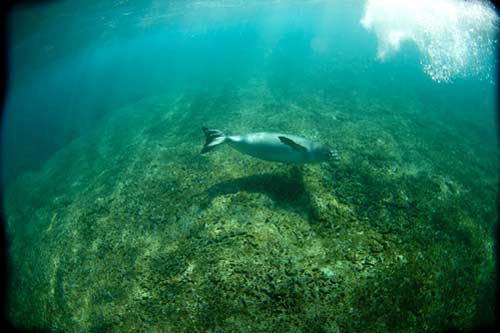GIVING BACK
Hawai‘i Wildlife Fund
Words :: Kirsten Whatley
“On your way back, you scan the sand for baby turtles emerging from another nest, instinctively trying to reach their saltwater home”
Ensuring that Hawai‘i’s endangered sea life has a future means making sure they get off to a good start. This a primary focus of the Hawai‘i Wildlife Fund (HWF). They help caretake the fragile ecosystems ringing the islands of Maui and the Big Island, and the creatures that live there— including critically endangered species such as the Hawaiian monk seal and hawksbill sea turtle. Started in 1996 by two former National Marine Fisheries Service scientists, Bill Gilmartin and Hannah Bernard, the HWF added Cheryl King to their team in 2000, where she spearheads the hawksbill nesting monitoring program on Maui.

In addition to the volunteer projects described below, Hawai‘i Wildlife Fund encourages snorkelers and divers on all islands to report hawksbill sightings for their database of near-shore turtle populations. Hawksbills live right alongside the more common green sea turtle (honu in Hawaiian), but there are visible differences—see www.wildhawaii.org for details. And if you have an underwater camera, taking pictures is the best for documenting a hawksbill sighting, while recording location, date, time, water depth, habitat type, behavior, reaction to you, along with other relevant information. Visit the HWF website for more, or contact Cheryl directly at (808) 385-5464.
___________________________________________________________
Give-Back Location: Hawai‘i Wildlife Fund, Maui
Sleeping on the beach has its lures—star-laden skies, sand in your hair, the lullaby of waves tumbling at the foot of your bed. Then the alarm goes off and you’re up again. It’s 2:00 a.m., and time to do another beach walk in search of a nesting hawksbill turtle—she’ll be appearing at the same place she has returned to every few years for a decade now.
On your way back, you scan the sand for baby turtles emerging from another nest, instinctively trying to reach their saltwater home. Not yet. You reset the alarm and lean back against a cushion of sand, breathing in the seaweed air, knowing that protecting these creatures from predators, and redirecting them away from lights and toward the ocean, gives your camping experience true purpose.
For those of you more prone to sun seeking than night vision, you can join the Hawai‘i Wildlife Fund response team that watches over Hawaiian monk seals when they haul out onto Maui’s beaches. You’ll take turns guarding a taped-off zone around the lounging seal, while educating onlookers about these glorious creatures and their behaviors.
On regular occasions, the HWF also takes to the shores with gloves and trash bags, picking up litter where it doesn’t belong. And they run Makai Watch, where you can help trained naturalists spread the good word of respecting the marine environment.
Contact: E-mail preferred.
Hannah Bernard
Hawai‘i Wildlife Fund
P.O. Box 790637
Pa‘ia, HI 96779
(808) 280-8124
[email protected]
www.wildhawaii.org
(For HWF beach cleanup projects on the Big Island, go to www.preservehawaii.org, click on Find Volunteer Opportunities, then “Hawai‘i Wildlife Fund” under Hawai‘i Island.)
This article is adapted from Preserving Paradise: Opportunities in Volunteering for Hawaii’s Environment. Courtesy of Island Heritage Publishing.

Click to Book go Mokulele Flight
16edaa4c-457e-4def-bc06-aa1d0fe9df1e|1|4.0